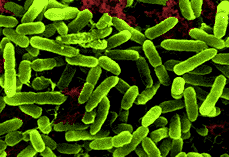Monera

http://www.williamsclass.com/SixthScienceWork/Classification/ClassificationNotes/images/kingdomMonera.gif
The kingdom Monera are the first life form to have evolved on planet earth. Organisms such as bacteria are classified under this kingdom, called Monera.
Some of the important and significant characteristics of Monera are that they are about 1 micrometer in size and complex as living molecules.
They are unicellular, lack nuclei and many other cell organelles and they have a cell wall made of polysaccharides with polypeptide cross links with a chemical called peptidoglycan.
Their plasma membrane is made of lipids and proteins.
They usually photosynthesise to get their supply of food.
Their cell structure is usually round, rod-like or spiral.
They reproduce asexually by binary fission or sexually by conjugation.
Their process of digestion and circulation is carried out through diffusion.
Examples of Monera include Actinomyces, Bacillus, Bactericides, Bordetella and Chlamydia
Protista

http://t2.gstatic.com/images?q=tbn:ANd9GcSO4rh6Ho-jCsmRfJ_Luo4Q0POVqnaWG9zsReU_haBED5Oxd43M
- Eukaryotes
- Unicellular
- Most reproduce by binary fission.
- Some protists perform photosynthesis like plants while others move around and act like animals, but protists are neither plants nor animals.
Examples of protists include amoeba, paramecium and kelp.
http://www.windows2universe.org/earth/Life/protista.html
http://www.schools.utah.gov/curr/Science/sciber00/7th/classify/sciber/5king2.htm
Fungi

http://t3.gstatic.com/images?q=tbn:ANd9GcSFJtu95yObI_AnU9LL7efeZDwhSg1-NJv2yum0UhvR19XFbqSH
- Eukaryotic; complex and have membranes
- Non-vascular organisms; no blood vessels
- Reproduce by means of spores usually dispersed by wind
- Able to produce both sexual and asexual spores
- Immobile
- Lack chlorophyll; unable to make food like plants
- Stores food in the form of glycogen
- Grow hyphae which form a mycelium
- Digests food before ingestion unlike other heterotrophic organisms (eg. animals)
- Cell wall made of chitin
http://www.uwlax.edu/biology/volk/fungi3/sld009.htm
http://www.buzzle.com/articles/characteristics-of-fungi.html
Done by Jie Min, Chin Fan and Wei Hong
I have found out that certain Monera can reproduce sexually through Conjugation. I have also discovered that Fungi digests foods before ingestion unlike other heterotrophic organisms like humans, who ingest food before digestion.
ReplyDeleteI have learnt that the the monera kingdom are the first form of life to have evolved on earth.
ReplyDeleteI have learnt that fungi digests foods before ingestion. I also learn that the kingdom Monera can photosynthesize
ReplyDeleteI have learnt that Monera can produce either asexually or sexually,and that fungi can produce both sexual and asexual spores.
ReplyDeleteI have learnt that some protists perform photosynthesis like plants while others move around and act like animals, but protists are neither plants nor animals
ReplyDeleteI have discovered that most algae contain chlorophyll however, they are not classified as Plantae.
ReplyDeleteI have learnt that Protista and Fungi are Eukaryotic and discovered that Monera is prokaryotic.
ReplyDeletei have learnt that most elgay contain chlorophyll, but they are not classified as plants
ReplyDeleteMonera:
ReplyDeleteI've learnt that... the kingdom monera are the first life form to have evolved on earth, that they are about 1 micrometer in size and complex as living molecules, their cell structure is usually round, rod-like or spiral,
they reproduce asexually by binary fission or sexually by conjugation.
Protista:
most reproduce by binary fission.
Fungi:
are eukaryotic
I've learnt that monera photosynthesise and they have cell walls.
ReplyDeleteI've learnt that fungi produces both sexual and asexual spores. They are also non-vascular organisms although they grow hyphae.
now i know :) tnx a lot
ReplyDelete